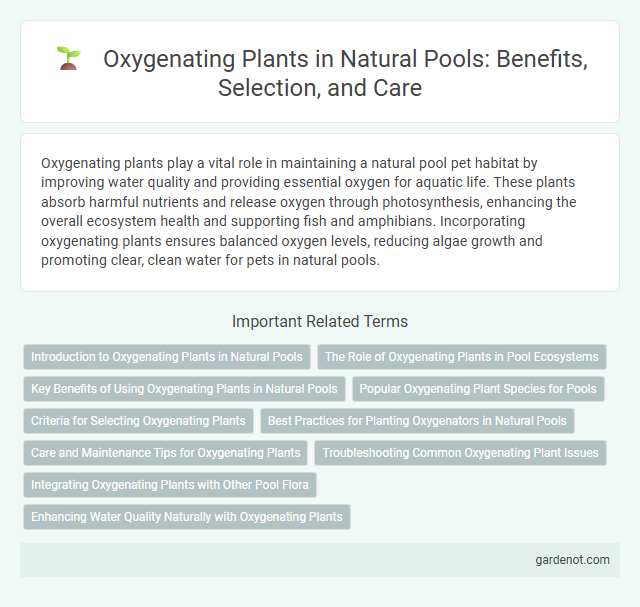Oxygenating plants play a vital role in maintaining a natural pool pet habitat by improving water quality and providing essential oxygen for aquatic life. These plants absorb harmful nutrients and release oxygen through photosynthesis, enhancing the overall ecosystem health and supporting fish and amphibians. Incorporating oxygenating plants ensures balanced oxygen levels, reducing algae growth and promoting clear, clean water for pets in natural pools.
Introduction to Oxygenating Plants in Natural Pools
Oxygenating plants play a crucial role in natural pools by enhancing water quality and supporting aquatic life through effective oxygen production. These submerged and floating species facilitate nutrient absorption and help prevent algae growth, maintaining ecological balance. Common examples include hornwort, anacharis, and waterweed, which thrive underwater and boost the pool's natural filtration system.
The Role of Oxygenating Plants in Pool Ecosystems
Oxygenating plants, such as Elodea and Hornwort, play a crucial role in natural pool ecosystems by increasing dissolved oxygen levels, which supports aquatic life and enhances water clarity. These submerged plants absorb carbon dioxide during photosynthesis, producing oxygen that helps maintain a balanced aquatic environment and prevents the growth of harmful algae. Their root systems also stabilize sediment, reducing turbidity and promoting a healthy, sustainable pool ecosystem.
Key Benefits of Using Oxygenating Plants in Natural Pools
Oxygenating plants play a crucial role in natural pools by improving water quality through increased oxygen levels, which promote aerobic bacteria that break down organic waste. These plants help maintain a balanced aquatic ecosystem, reducing algae growth and minimizing the need for chemical treatments. Their natural filtration properties enhance water clarity and support healthy aquatic life.
Popular Oxygenating Plant Species for Pools
Popular oxygenating plant species for natural pools include Elodea canadensis, Ceratophyllum demersum, and Myriophyllum spicatum, known for their high oxygen release and low maintenance. These submerged plants improve water quality by absorbing excess nutrients and providing habitat for beneficial microorganisms. Integrating species like Vallisneria americana and Potamogeton crispus enhances oxygenation while supporting a balanced aquatic ecosystem.
Criteria for Selecting Oxygenating Plants
Selecting oxygenating plants for a natural pool requires evaluating species based on their oxygen production capacity, growth rate, and adaptability to local climate conditions. Effective oxygenators like Elodea canadensis and Myriophyllum spicatum enhance water quality by increasing dissolved oxygen levels, supporting aquatic life and preventing algae growth. Consider plants with robustness, minimal maintenance needs, and compatibility with the pool's ecosystem to maintain a balanced and healthy aquatic environment.
Best Practices for Planting Oxygenators in Natural Pools
Plant oxygenators such as Hornwort, Elodea, and Cabomba play a crucial role in maintaining water clarity and oxygen levels in natural pools by absorbing nutrients and providing habitat for beneficial microorganisms. Best practices for planting these oxygenators include selecting species suited to the pool's depth and temperature, placing them in well-lit areas to maximize photosynthesis, and spacing plants adequately to prevent overcrowding and ensure healthy growth. Regular monitoring and partial plant harvesting help manage nutrient cycles and prevent excessive biomass that can lead to water quality issues.
Care and Maintenance Tips for Oxygenating Plants
Oxygenating plants like hornwort and anacharis thrive in natural pools with consistent sunlight and nutrient-rich water, requiring regular pruning to prevent overgrowth and maintain water clarity. Maintaining water quality by monitoring pH levels between 6.5 and 7.5 supports healthy plant development and enhances oxygen production. Periodic removal of decayed plant matter and avoiding chemical fertilizers preserve the ecological balance essential for optimal performance of oxygenating plants.
Troubleshooting Common Oxygenating Plant Issues
Oxygenating plants in natural pools play a critical role in maintaining water quality by supplying oxygen to aquatic ecosystems. Common issues include yellowing leaves, which often indicate nutrient imbalances or insufficient light, and algae overgrowth caused by poor plant health or stagnant water. Regular inspection and adjusting water parameters such as nutrient levels, light exposure, and circulation can effectively troubleshoot and prevent these problems, promoting a balanced and thriving natural pool environment.
Integrating Oxygenating Plants with Other Pool Flora
Integrating oxygenating plants such as hornwort (Ceratophyllum demersum) and waterweed (Elodea canadensis) with marginal plants like cattails and pickerelweed enhances the natural pool's filtration system by balancing oxygen levels and nutrient absorption. These oxygenators increase dissolved oxygen, supporting beneficial bacteria that decompose organic matter, while marginal plants prevent algae overgrowth through shading and competition for nutrients. Proper plant zoning maximizes water clarity and biodiversity, creating a self-sustaining aquatic ecosystem within the natural pool.
Enhancing Water Quality Naturally with Oxygenating Plants
Oxygenating plants play a crucial role in natural pools by improving water quality through the release of oxygen into the water, which supports beneficial aerobic bacteria that break down organic matter. Species such as hornwort (Ceratophyllum demersum) and waterweed (Elodea canadensis) effectively reduce algae growth by competing for nutrients and increasing dissolved oxygen levels. Integrating these plants into the pool ecosystem promotes clear, healthy water while minimizing the need for chemical treatments.
Oxygenating plant Infographic

 gardenot.com
gardenot.com